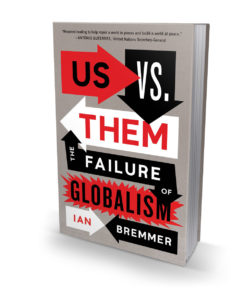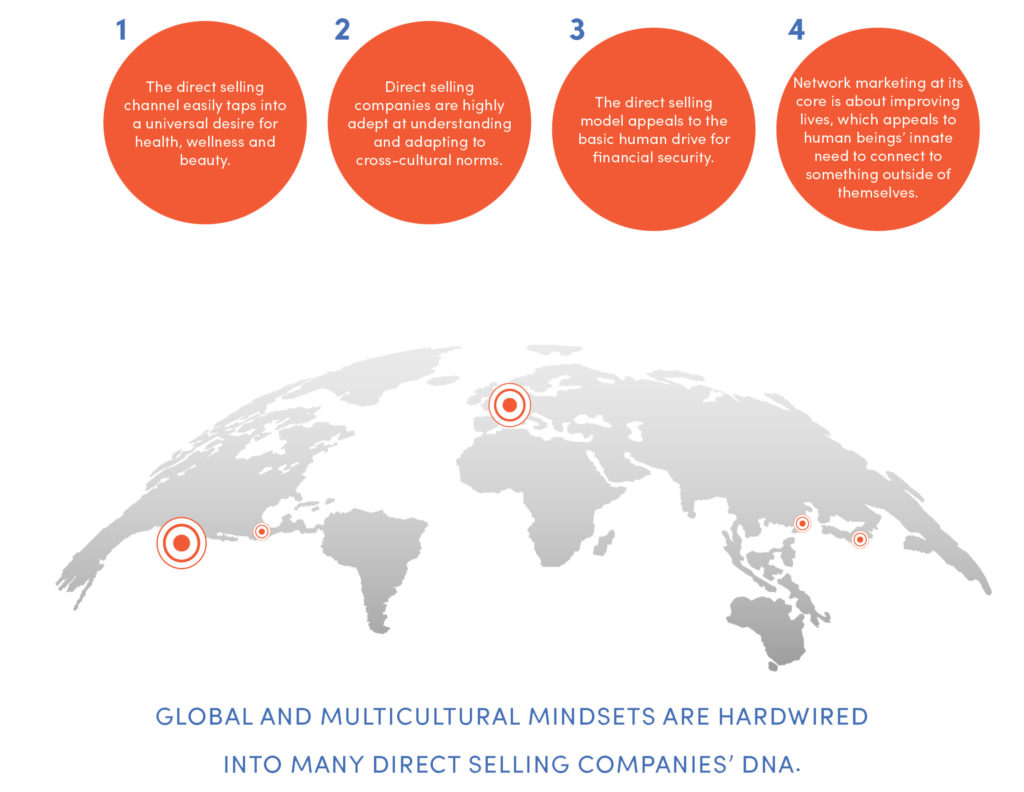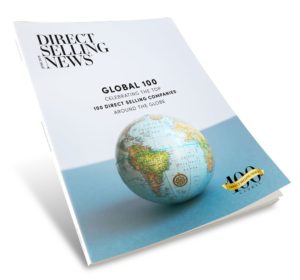In this issue:
- List of Top 100 Companies
- DSN Welcomes Executives and Guests to its Global 100 Evening of Celebration
- Global Good: Why Direct Selling Succeeds Beyond Our Borders
- 5 Best Practices for Making It Work in the Global Market
- Frequently Asked Questions about the Global 100 Ranking
- Bravo Legacy Award: D. Gary Young: A Lasting Legacy For Future Generations
- Bravo Leadership Award: Joni Rogers-Kante: Her Vision and Focus Keep Moving SeneGence Forward
- Bravo Growth Award: MONAT: Opportunities Lead to Growth and Limitless Possibilities
- Back Page: Partners in Self-Regulation for all of Direct Selling
The global economy is in an interesting state right now.
On one hand, U.S.-based businesses are more optimistic than ever about their overseas prospects, according to Wells Fargo’s 2017 International Business Indicator survey. A strong U.S. dollar, changing regulations and untapped consumers in emerging markets are giving domestic companies incentives to explore and expand beyond America’s borders.
On the other hand, the impending Brexit (the United Kingdom’s plan to leave the European Union in 2019), threats of trade wars, uncertainty over trade pacts and stark divides over multiculturalism are dampening corporate enthusiasm for thinking and acting globally, according to the Wells Fargo survey.
“Larger societal and geopolitical shifts are causing American CEOs more concern than any “dynamics in their own markets.”

The survey revealed that more than 85 percent of respondents said they are concerned that potential failure of trade pacts such as the North American Free Trade Agreement could adversely affect their international business. According to a recent survey by PwC, larger societal and geopolitical shifts are causing American CEOs more concern than any “dynamics in their own markets.” In his new book Us vs. Them: The Failure of Globalism, author and Eurasia Group Founder Ian Bremmer says there is a retreat from globalism not only in established regions such as the Americas and Europe but in developing markets such as Indonesia and Turkey.
At the very least, the world is engaged in economic, cultural and political tug-of-war, and everyone’s heels seem deeply dug in. So, where does direct selling fit into this scene? With global and multicultural mindsets hardwired into many direct selling companies’ DNA, the channel seems to be in the picture without being part of the picture.
Global direct selling revenue hit $182 billion and more than 107 million people worldwide were involved in international direct sales in 2016, according to the World Federation of Direct Selling Associations (WFDSA). (WFDSA will release 2017 global direct selling statistics later this summer.)The three-year compound annual sales growth rate was 5.2 percent. The U.S. Direct Selling Association conservatively estimates that 58 percent of its members have an international business presence.
The channel’s natural ability to succeed consistently in international markets stems from four basic characteristics:
- The direct selling channel easily taps into a universal desire for health, wellness and beauty.
- Direct selling companies are highly adept at understanding and adapting to cross-cultural norms.
- The direct selling model appeals to the basic human drive for financial security.
- Network marketing at its core is about improving lives, which appeals to human beings’ innate need to connect to something outside of themselves.
Wellness & Personal Care Products On the Rise
On a pure retail level, direct selling is heavily weighted toward products that appeal to consumers in all cultures, at all socioeconomic levels.
More than 60 percent of the 44 U.S.-based companies on the 2017 Direct Selling News Global 100 list provide products for health and wellness or skincare or both. “People around the world want beauty and wellness products,” says Kay Zanotti, CEO of Arbonne, an Irvine, California-based company that sells self-care products in such countries as Australia, Poland and Taiwan and had global sales of $553 million in 2017, one-third of which came from non-U.S. markets. “Everyone wants to look and feel their best.”
According to WFDSA, wellness products account for 35 percent of direct selling categories around the world, followed by cosmetics, which account for 30 percent. The percentage of sales from nutrition products last year at Amway, the world’s largest direct selling company according to the Global 100 list, is even higher, at 50 percent. Amway’s personal-care and beauty products accounted for 26 percent of the company’s sales last year.
The trend toward taking care of the body, inside and out, is only growing, says DSA Executive Vice President Adolfo Franco. “That’s why you see a lot of direct selling companies diversifying into those categories.”

Adapting to Market Needs
The best products in the world may not sustain a company that can’t bridge cultural differences, though. The ability to integrate other customs and business processes is perhaps the biggest differentiator between U.S. companies that make it beyond U.S. borders and those that don’t. A number of traditional American brands have fallen flat in international markets when they’ve tried to do business there the way they do business in the U.S.
Earlier in the 2000s, eBay lost its bid in Japan in part because it required credit card payments at a time when Japanese shoppers preferred to pay cash on delivery. Best Buy scrapped its European and Chinese operations when it realized shoppers there didn’t like big box stores. U.S. companies also tend to announce global launches before they happen—giving local competitors a chance to get to consumers first. And they often assume shoppers in non-U.S. markets will respond to advertising strategies that work in the States.
The bottom line in these commerce and cultural missteps is that these companies didn’t take time to understand, adapt to and earn trust in these new markets. This is where direct selling companies have a natural advantage, say executives like Steve Wallach, CEO of Chula Vista, California-based Youngevity, which sells nutrition and beauty products in markets such as Southeast Asia, Eastern Europe, Latin America, Japan and Canada. Youngevity is relatively, well, young in the international market, generating just 9 percent of its revenue overseas last year. This is the reverse of such companies as USANA and Herbalife, both of which generated, at most, one-fourth of their revenue domestically in 2017. But Youngevity is closely watching those that have gone before it, and Wallach says he is learning how to navigate these new waters.
“Direct selling is a people business,” Wallach says. “That’s what transcends international markets. If you don’t like people, you’re in the wrong business.” WFDSA Executive Director Tamuna Gabilaia says that people are so central to the model that the channel doesn’t need to invest the same kind of money promoting it as conventional business does, “We do not spend millions of dollars on advertising. We are a word-of-mouth industry.”
Relationships First, Products Second

The business model of focusing on relationships first and products second aligns well with how business works in countries like China, which many consider the holy grail of international markets, with $33 billion in direct selling revenue in 2016, second only to the United States. Even if upcoming 2017 stats change that number, China’s increasing relevance is not going away. Case in point: eBay’s initial efforts in China failed because it didn’t understand a cultural concept called guanxi, the country’s unwritten rules for developing the social networks and influential relationships that are critical for success in that market. And while China has some incredibly stringent network marketing regulations, direct selling companies are more likely to inherently understand and be successful with a concept like guanxi because they are seasoned relationship builders.
Sandy, Utah-based 4Life Research generated at least half of its $316 million 2017 revenue from outside the United States—in countries such as Korea, Mexico and Germany—and is developing inroads to China. “There’s a proper way to create relationships there,” says Co-Founder David Lisonbee, echoing the theme of how important it is to understand a country’s culture and regulatory processes. “We cannot do it alone—we have to hire local people, engage attorneys and work with consultants who understand the intricacies of the terrain.”
“Trying to get a population of people to change to the way you do business as opposed to you changing to the way they do business is an important distinction.”
—Steve Wallach, CEO, Youngevity
Bianca Lisonbee, also co-founder of 4Life and wife to David, agrees that, in general, direct selling companies succeed internationally where others might not because of the channel’s “built-in communal experience.” Many traditional business models are built around competition but in networking marketing, “I can’t succeed if I can’t help you to succeed,” she says.
Aside from knowing how to navigate and integrate cultural norms, U.S. direct selling companies that succeed globally have the capacity to adjust their products to fit various regulatory requirements. “It would be wonderful if everybody’s rules were standardized, but they’re not,” Wallach says, explaining that Youngevity often changes the formulas in its supplements and juices to meet the criteria of different health ministries. The key to maintaining the integrity of a brand in these situations is to make sure the products deliver the same results regardless of the ingredients, Wallach says.
Arbonne also customizes the contents of its nutrition and beauty products depending on the market, Zanotti says. “With global preference with formulas, we did extensive testing to ensure that expectations would be met in the new market and made any formula adjustments before launch,” she says.
Entrepreneurial Spirits
A desire to be in control of one’s time and earning potential may be as potent as the desire for health and wellness, direct selling executives say—marking another motivator that makes network marketing a natural fit in many corners of the world.
“People overwhelmingly want to better themselves and have a positive impact on their families,” says Amway Chief Sales Officer John Parker. Half of the nearly 49,000 respondents to the latest Amway Global Entrepreneurship Report (AGER) in 2018, which covered 44 countries, said they have a strong desire to start their own business. Some individual regions had even higher response rates—including Latin America, where 73 percent of respondents expressed a strong entrepreneurial desire, followed by Asia, with 69 percent.
“We think human behavior is the same everywhere,” says Jere Thompson, co-founder and CEO of Dallas, Texas-based Ambit Energy, which launched in Japan in May 2017. “People like to save money and people like to make money.”
“This industry is way ahead in helping to create independent contractors, more flexible work. Only now are other businesses starting to catch on to that. “
—David Lisonbee, Co-Founder, 4Life Research
Beyond the chance to control one’s income, direct selling also typically offers low barriers to entry, says DSA’s Franco. Startup costs are minimal and there’s often little or no training required to become a consultant. “The opportunity for easy entrée into a market with low cost, especially in the more challenged markets in the world, and to be able to work from home, to work at one’s own pace and skill set—that’s a huge consideration,” Franco says.
The emergence of the gig economy (the Ubers, the Airbnbs, the Door Dashes) has made direct selling even more attractive as it recruits independent business owners around the world. But direct selling was gig before there was gig, executives say. “This industry is way ahead in helping to create independent contractors more flexible work,” says David Lisonbee. “Only now are other businesses starting to catch on to that.” Adds Bianca, “Network marketing has been teaching people to fish for a long time.”
While the channel has benefited from a cross-cultural interest in financial independence, it’s important not to assume that all entrepreneurial mindsets are alike, Thompson adds. While many people in Japan, for example, are beginning to see self-employment as a viable alternative to working 12-hour days, the protocol for establishing these kinds of opportunities is different than it is in the United States. American entrepreneurs “want things to happen quickly,” Thompson says. But the Japanese take as much time as necessary to make sure every box is checked before giving an outside company their stamp of approval.
“Trying to get a population of people to change to the way you do business as opposed to you changing to the way they do business is an important distinction,” Wallach adds.
Franco expands on the unique economics of the direct selling model by pointing out that it is somewhat immune to changing market conditions because of the nature of the business model. “It’s a resilient business channel,” he says. When traditional jobs are scarce, people often turn to direct selling to maintain their income. But even when job growth is on the rise, direct selling recruitment tends to be flat at its worst, he says. Gabilaia agrees. “When economic conditions are good, our industry’s growing. When economic conditions are not so good, our industry is still growing—or stable,” she says.
Social Good
If a company sells a solid product that delivers what it promises, that’s a good thing. An even better thing, according to Gabilaia, is when a company also does good things for the communities where its distributors and customers live. “What we have seen is that people pay more attention to how the products they’re buying help social causes,” she says, and direct selling takes corporate responsibility very seriously.
“Our industry has a heart and it always has,” Gabilaia says. Charitable contributions from the directs selling companies that WFDSA surveyed last year were up 23 percent to more than $204 million, an average contribution of $4.3 million. And that doesn’t include contributions from independent business owners or in-kind contributions, she added.
—5 Best Practices for Making It Work in the Global Market—
Forty-four companies in the survey reported giving a total of $76 million to charitable causes outside the United States in 2016. Among 41 companies that reported donations for both 2015 and 2016, reported giving increased 54 percent in 2016, according to WFDSA.
“There’s a universality of filling basic human needs that crosses all cultures,” Bianca Lisonbee says. “Not just with products but in the need to feel part of the community, part of something bigger than ourselves.”
According to Amway’s research, doing business for a higher purpose is a common desire among would-be entrepreneurs, too. Forty percent of AGER survey respondents said they would be motivated by social reasons more than profit reasons to start their own business.
Time and Patience
Just because direct selling has advantages that prime it for being successful internationally doesn’t mean there aren’t frustrations, executives say. From complicated, bureaucratic regulations to language barriers to basic time zone differences, the realities of working across borders can test even the most seasoned company’s resolve. But Jere Thompson learned from Ambit’s experience in Japan that the only way a company can close the gap between the U.S. experience and the global experience is by being deliberate and persistent. “One foot goes in front of the other,” he says. “And only after a certain distance will the next gate come open.”




